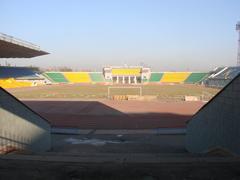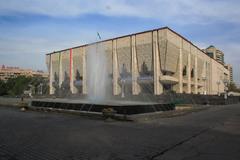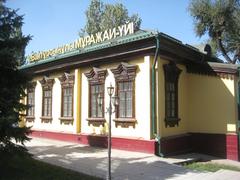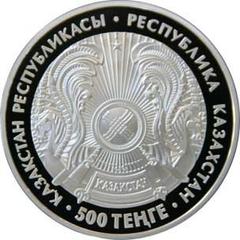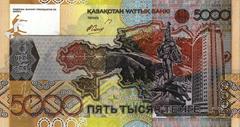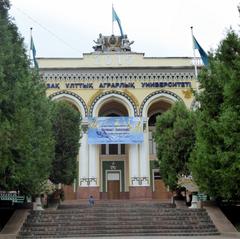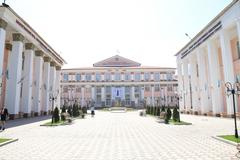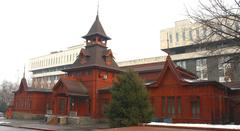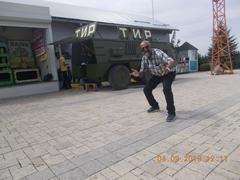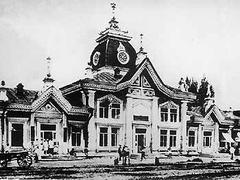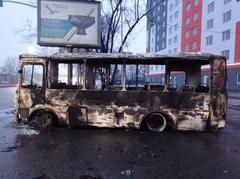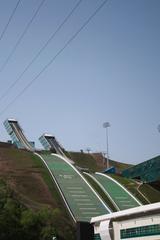Kazakh-British Technical University Visiting Hours, Tickets, and Visitor Information in Almaty, Kazakhstan
Date: 03/07/2025
Introduction
Situated in the heart of Almaty—Kazakhstan’s largest city and a vibrant cultural hub—the Kazakh-British Technical University (KBTU) building is a key site reflecting the city’s layered history and architectural heritage. Originally designed as the Government House for the Kazakh SSR during the Soviet era, this imposing edifice encapsulates a journey of political transformation, ambitious architecture, and educational progress. Since its completion in 1957, the building has witnessed pivotal moments, including Kazakhstan’s declaration of independence in 1991. Today, it serves as the dynamic campus of KBTU, a leading institution specializing in vital sectors such as oil and gas, IT, and finance.
Visitors to the KBTU building can admire its Soviet monumental architecture, explore its historical significance, and enjoy its central location surrounded by other cultural landmarks such as Panfilov Street, the National Library, and Astana Square. The adjacent KBTU Monument highlights the university’s commitment to international collaboration and academic achievement, while nearby sites like the Old Square Monument and Astana Square provide further opportunities to experience Almaty’s historical evolution.
This comprehensive guide offers essential information for travelers considering a visit to the KBTU building and its surrounding attractions. Readers will find details about the historical context, architectural features, visiting logistics, accessibility, and transportation, as well as tips for making the most of their time in Almaty. For further research, consult resources like Silk Road Adventures, Wikipedia: KBTU Building, and Visit Almaty.
Contents Overview
- Historical Evolution of the KBTU Building
- Architectural Significance
- Visiting the KBTU Building: Practical Information
- The Building’s Role in Almaty’s Cultural Landscape
- Monument Guide: KBTU Monument
- Old Square Monument: Visitor Guide
- Visiting Astana Square and Surrounding Sites
- Summary and Visitor Recommendations
- Sources and Further Reading
Historical Evolution of the KBTU Building
Origins and Construction
The KBTU building is a landmark rooted in Almaty’s Soviet-era history. Initial plans began in 1933 for a new Government House but were stalled by World War II; only the foundations had been completed by 1941. Construction resumed in 1951 and the building was finished in 1957, costing 14 million rubles (Wikipedia; Silk Road Adventures). The design, created by Mosproject under Boris Rubanenko and executed by Kazgorstroyproekt, originally called for a dramatic dome and Soviet-themed sculptures. Budget constraints, however, led to a more restrained—yet still grand—classical Soviet style (Silk Road Adventures).
Political and Cultural Milestones
Initially the seat of the Supreme Soviet of the Kazakh SSR, the building gained historical prominence when the law declaring Kazakhstan’s independence was adopted here in 1991 (Wikipedia). From 1998 to 2001, it housed the Almaty regional administration. In 2001, a government decree designated the building as the new home of KBTU, marking its transformation from a political institution to an educational one (Silk Road Adventures).
Monument Status
The building is officially recognized as a monument of republican significance and is included in the state list of historical and cultural monuments (No. 10), further affirming its place in Almaty’s heritage (Silk Road Adventures).
Architectural Significance
Design and Style
The KBTU building is a notable example of Soviet monumental architecture—marked by grand symmetry, classical motifs, robust stonework, and a stately façade. While the original dome and sculptures were omitted due to financial limitations, the building’s imposing presence and balanced proportions remain emblematic of mid-20th-century civic design. Its location on Astana Square further cements its role as a city landmark (Silk Road Adventures; Wikipedia).
Notable Features and Renovations
The main hall, a key interior space, has hosted historic events, including the independence declaration. In 2018, it underwent significant restoration, preserving its historical character while modernizing its facilities (Wikipedia). The building’s exterior features grand staircases, rhythmic columns, and large windows, providing natural light and monumental scale.
Urban Context
Located at the intersection of Abylai Khan Avenue and Panfilov Street, the KBTU building sits within a corridor of cultural significance, close to the National Library and Writers’ Union. Its silhouette is a recognizable symbol of Almaty, bridging Soviet heritage and modern aspirations (Visit Almaty).
Visiting the KBTU Building: Practical Information
Visiting Hours and Tickets
KBTU is an active university campus. Public access to historical areas such as the main hall is typically available during official events, open days, or through guided tours. Always check the official KBTU website or contact the administration for current visiting hours and ticketing information.
Accessibility
Located centrally, the building is accessible by public transport, taxi, or on foot. Some accessibility accommodations exist, but due to the building’s age and historical protections, visitors with mobility needs should inquire in advance about available facilities.
Guided Tours and Tips
Guided tours are occasionally organized, offering deeper insight into the building’s history and significance. Combine your visit with other nearby landmarks—such as Panfilov Street, the National Library, or the Ascension Cathedral—for a broader exploration of Almaty’s rich architectural heritage.
The Building’s Role in Almaty’s Cultural Landscape
Educational Transformation
Since 2001, KBTU has specialized in training professionals for Kazakhstan’s vital industries, notably oil and gas, IT, and finance (Silk Road Adventures). Its presence has revitalized the historic structure, drawing students and academics from across the region.
Integration with City Life
The building’s central location makes it a key stop for tourists and locals exploring the city’s architecture, history, and culture. It is often featured in walking tours alongside other iconic sites like the Ascension Cathedral and National Library (Visit Almaty; Wanderlog).
Preservation and Public Access
As a protected monument, the building is maintained under strict preservation guidelines. While it functions as a university, public access is offered during special events and tours, supporting Almaty’s commitment to architectural conservation (Silk Road Adventures).
Monument Guide: KBTU Monument
Significance
The KBTU Monument, located on campus, celebrates the university’s influence on Kazakhstan’s educational and technological development. It symbolizes KBTU’s dedication to academic excellence and international collaboration.
Visitor Information
- Location: KBTU Campus, Almaty
- Hours: Monday–Friday, 9:00 AM–6:00 PM; closed weekends and public holidays
- Tickets: Free entry
- Accessibility: Wheelchair accessible
Travel Tips
- Transport: Reachable by public bus (routes 12, 45) or taxi.
- Nearby Attractions: Al-Farabi Park, Central State Museum.
- Best Season: Spring and autumn offer ideal weather.
Events and Activities
Guided tours and cultural events are held near the monument during academic open days and national holidays. Check the KBTU website for updates.
FAQ
- Photography: Permitted.
- Campus Access: Building interiors require permission; monument grounds are open to all.
- Guided Tours: Available upon request, especially during events.
Old Square Monument: Visitor Guide
Overview
The Old Square Monument, adjacent to KBTU, is a central city landmark and frequent venue for public events, festivals, and gatherings. It reflects the city’s resilience and cultural identity, blending neoclassical style with the historic urban setting.
Visitor Information
- Hours: Daily, 8:00 AM–10:00 PM
- Admission: Free
- Accessibility: Wheelchair accessible
Events and Activities
Old Square hosts numerous city festivals and concerts. For event schedules, refer to the Almaty City Tourism Website.
Photographic Tips
- Capture images in early morning or late afternoon for optimal lighting.
- Notable backdrops include the monument’s pillars, fountains, and surrounding green spaces.
Nearby Attractions
- KBTU Building: Architectural highlight
- Zenkov’s Cathedral: Wooden Orthodox church
- Green Bazaar: Local goods and cuisine
- Central Mosque: Another key landmark
Travel Tips
- Language: Kazakh and Russian are widely spoken; English is common in tourist areas.
- Connectivity: Free Wi-Fi is available in many cafes and public spaces.
Astana Square and Surrounding Sites
Overview and Significance
Astana Square is a vibrant public space central to Almaty’s heritage. It features monuments related to Kazakhstan’s history and independence and is surrounded by early 20th-century architecture and public art.
Visiting Hours and Tickets
- Square: Open 24/7, free access.
- Nearby Museums:
- Central State Museum: Tues–Sun, 10:00 AM–6:00 PM, ~500 KZT, closed Mondays
- Ascension Cathedral: Daily, 9:00 AM–7:00 PM, free entry
Tours and Events
Guided walking tours are available through local operators and often include stops at the square, Panfilov Street, and the Central State Museum. Astana Square also hosts seasonal festivals and ceremonies.
Facilities
- Dining: Numerous cafes and restaurants along Panfilov Street
- Restrooms: In nearby shopping centers and museums
- Wi-Fi: Widely available
Getting There
- Metro: Almaly station
- Bus/Trolleybus: Multiple lines serve the area
- Taxi: Apps like Yandex Go and inDriver
Nearby Attractions
- Panfilov Street and Arbat: Shops and street performances
- Green Bazaar: Foods and souvenirs
Local Etiquette
- Dress modestly for religious sites and be respectful during photography.
- Tipping is customary in restaurants (5–10%).
Summary and Visitor Recommendations
A visit to the Kazakh-British Technical University and its surrounding monuments offers an immersive experience into Kazakhstan’s history, architectural heritage, and modern cultural identity. The KBTU building, with its Soviet roots and academic transformation, stands as a symbol of Almaty’s dynamic evolution. Nearby sites like the KBTU Monument, Old Square Monument, and Astana Square offer additional layers of history, culture, and public life. These attractions are easily accessible and are often included in walking tours of the city’s most iconic locations.
To maximize your visit:
- Check event schedules and guided tour availability in advance.
- Combine your KBTU visit with nearby attractions for a comprehensive itinerary.
- Download the Audiala app or Almaty Cultural Sites app for up-to-date guides, maps, and event information.
- Refer to official sources for the latest visitor updates.
For more details, consult Silk Road Adventures, Visit Almaty, and the Almaty City Tourism Website.
Sources and Further Reading
- KBTU Building, 2023, Wikipedia
- KBTU Building Almaty, 2023, Silk Road Adventures
- Cultural Almaty, 2023, Visit Almaty
- Almaty Old Square Monument, 2023, Almaty City Tourism Website
- Astana Square Visitor Guide, 2023, Advantour
- Central State Museum of Kazakhstan, 2023, Official Site
- Almaty Tourism Center, 2023, Official Site

